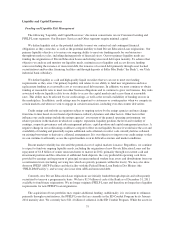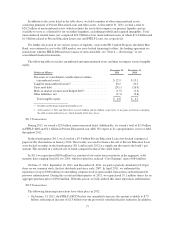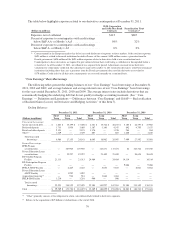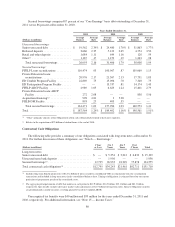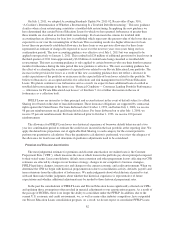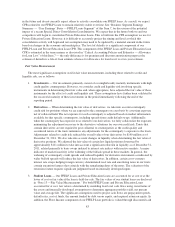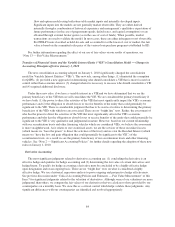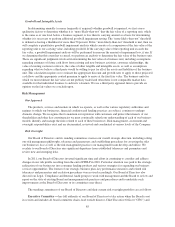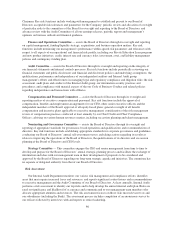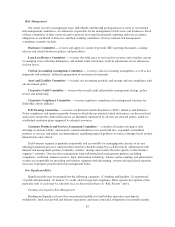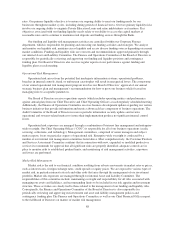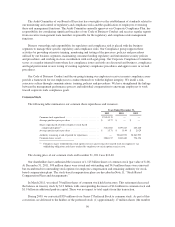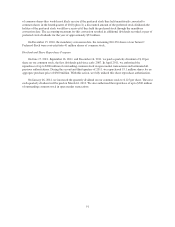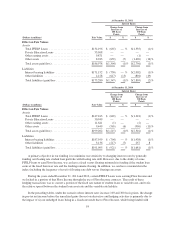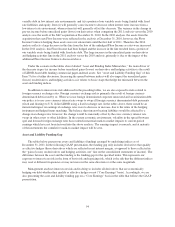Sallie Mae 2011 Annual Report Download - page 87
Download and view the complete annual report
Please find page 87 of the 2011 Sallie Mae annual report below. You can navigate through the pages in the report by either clicking on the pages listed below, or by using the keyword search tool below to find specific information within the annual report.Goodwill and Intangible Assets
In determining annually (or more frequently if required) whether goodwill is impaired, we first assess
qualitative factors to determine whether it is “more-likely-than-not” that the fair value of a reporting unit, which
is the same as or one level below a business segment, is less than its carrying amount as a basis for determining
whether it is necessary to perform additional goodwill impairment testing. The “more-likely-than-not” threshold
is defined as having a likelihood of more than 50 percent. If this “more-likely-than-not” threshold is met, then we
will complete a quantitative goodwill impairment analysis which consists of a comparison of the fair value of the
reporting unit to our carrying value, including goodwill. If the carrying value of the reporting unit exceeds the
fair value, a goodwill impairment analysis will be performed to measure the amount of impairment loss, if any. If
we determine that this event has occurred, we perform an analysis to determine the fair value of the business unit.
There are significant judgments involved in determining the fair value of a business unit, including assumptions
regarding estimates of future cash flows from existing and new business activities, customer relationships, the
value of existing customer contracts, the value of other tangible and intangible assets, as well as assumptions
regarding what we believe a third party would be willing to pay for all of the assets and liabilities of the business
unit. This calculation requires us to estimate the appropriate discount and growth rates to apply to those projected
cash flows and the appropriate control premium to apply to arrive at the final fair value. The business units for
which we must estimate the fair value are not publicly traded and often there is not comparable market data
available for that individual business to aid in its valuation. We use a third party appraisal firm to provide an
opinion on the fair values we conclude upon.
Risk Management
Our Approach
The products, services and markets in which we operate, as well as the various regulatory authorities and
regimes to which our businesses, financial condition and lending practices are subject, continue to undergo
dramatic change. We recognize that to maintain our reputation with customers and protect the interests of our
shareholders and other key constituencies we must continually refresh our understanding of each of our business
models, identify and manage the risks related to each of these businesses. Risk management, assessment and
oversight responsibilities exist and are documented, reviewed and coordinated at various levels of the Company.
Risk Oversight
Our Board of Directors and its standing committees oversee our overall strategic direction, including setting
our risk management philosophy, tolerance and parameters; and establishing procedures for assessing the risks
our businesses face as well as the risk management practices our management team develop and utilize. We
escalate to our Board of Directors any significant departures from established tolerances and parameters and
review new and emerging risks.
In 2011, our Board of Directors invested significant time and effort in continuing to consider and address
changes in our risk profile resulting from the end of FFELP in 2010. Particular attention was paid to the strategic
redirection of our businesses into consumer lending products and various strategies for expanding our business
services opportunities. The format of our strategic business plan, key performance measures and related risk
tolerances and parameters and escalation procedures were revised accordingly. Our Board of Directors also
directed our Legal, Compliance and Internal Audit groups to work with management and the Board to review and
report on the state of existing Board and management risk practices and procedures and to undertake such
improvements as the Board of Directors or its committees may direct.
The standing committees of our Board of Directors and their current risk oversight portfolios are as follows:
Executive Committee — has full authority of our Board of Directors to take action when the Board is not
in session and includes all board committee chairs, lead outside director, Chief Executive Officer (“CEO”) and
85


